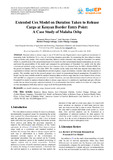| dc.contributor.author | Emoru, K. E. | |
| dc.contributor.author | Chelule, J. C. | |
| dc.contributor.author | Imboga, H. | |
| dc.contributor.author | Ayubu, Anapapa O. | |
| dc.date.accessioned | 2021-04-29T11:46:21Z | |
| dc.date.available | 2021-04-29T11:46:21Z | |
| dc.date.issued | 2020-11 | |
| dc.identifier.citation | American Journal of Applied Mathematics and Statistics, 2020, Vol. 8, No. 3, 96-102. DOI:10.12691/ajams-8-3-3 | en_US |
| dc.identifier.uri | https://www.researchgate.net/publication/346744988_Extended_Cox_Model_on_Duration_Taken_to_Release_Cargo_at_Kenyan_Border_Entry_Point_A_Case_Study_of_Malaba_Osbp | |
| dc.identifier.uri | http://pubs.sciepub.com/ajams/8/3/3/ | |
| dc.identifier.uri | http://pubs.sciepub.com/ajams/8/3/3/ | |
| dc.identifier.uri | http://www.sciepub.com/ajams/abstract/12484 | |
| dc.identifier.uri | https://www.semanticscholar.org/paper/Extended-Cox-Model-on-Duration-Taken-to-Release-at-Emoru-Chelule/f1721c0eed965f5d5514c2bbf101721d11f82554 | |
| dc.identifier.uri | http://hdl.handle.net/123456789/4619 | |
| dc.description.abstract | Duration taken to release cargo is one of World Customs Organisation’s most significant instruments of measuring trade facilitation. It is a way of reviewing clearance procedure by measuring the time taken to release cargo at border entry points. This research therefore aimed to model clearance time using the Extended Cox model, which is a modification of the proportional hazard Cox model in which proportional hazard assumptions are not met, and tested the practicability of the model and compared the performance of Extended Cox model with the other conventional methods using secondary data on time clearance that was obtained from the KRA, Malaba OSBP, for the period 1st January 2015 to 31st July 2019. The variables in the study were both time depend (time taken from registration to release) and time independent (customs regimes, origin, destination, customs value and description of goods). The variables used in the research project were tested for proportional hazard assumptions. Extended Cox model was the most suitable model for analysis duration taken to release cargo data has it was found to have a lower AIC and BIC as compared to conventional cox model. Therefore, customs administration should embrace the use of Extended Cox model to analysis duration taken to release cargo data as it is statistically significant and give efficient results that are based on proper statistical methods. It is recommended that further studies to be done on a large data set that encompasses both entry and exit cargo in all the Kenyan border points. | en_US |
| dc.language.iso | en | en_US |
| dc.publisher | Science and Education Publishing | en_US |
| dc.subject | cox model, duration, cargo, kenyan border, entry points | en_US |
| dc.title | Extended Cox Model on Duration Taken to Release Cargo at Kenyan Border Entry Point: A Case Study of Malaba Osbp | en_US |
| dc.type | Article | en_US |

